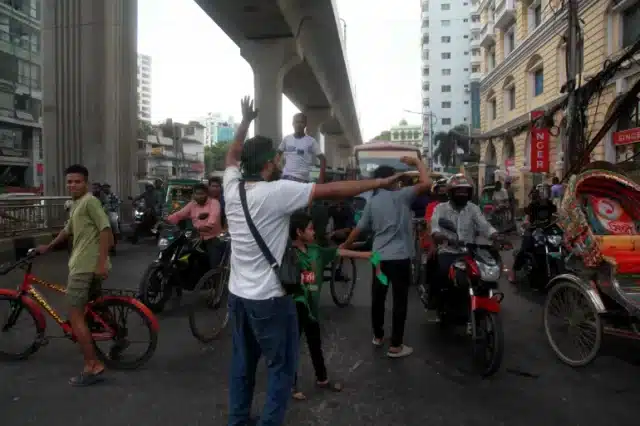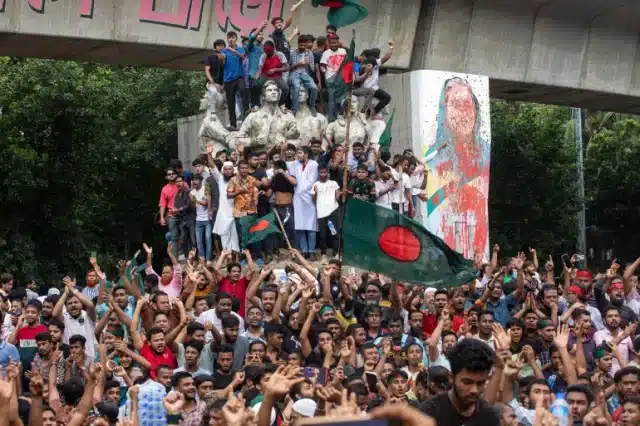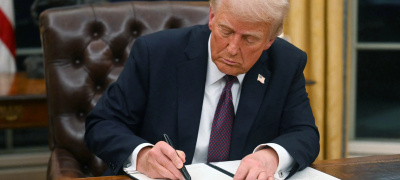The day after Sheikh Hasina’s 15-year autocratic regime ended, Dhaka, the capital of Bangladesh, took on a notably subdued and unusual atmosphere.
Previously bustling streets, filled with celebratory crowds following Hasina’s departure around 2pm (08:00 GMT) on Monday, were now quieter, with reduced vehicle and pedestrian traffic.
Read more: Dark Days are Ahead for Bangladesh
The most noticeable change was the total absence of police presence—no constables, officers, or traffic sergeants could be seen in the city of approximately 20 million residents.
In many areas, traffic was being managed by young people in their twenties. At the Bijoy Sarani intersection, a key junction leading to the airport and parliament, about five or six young men used bamboo sticks and even a cricket bat to direct traffic.
One individual, sporting a pointed goatee, managed the flow of cars towards the Tejgaon Industrial Area, using a bamboo stick to alternate traffic between the airport and Tejgaon in an organized manner.

The area where an iconic bronze statue of Sheikh Mujibur Rahman, Bangladesh’s founding father and Hasina’s father, once stood had also seen a dramatic transformation.
On Monday night, a large crowd used ropes to topple the statue and dismantled its base with hammers and chisels. People eagerly gathered the fragments of the fallen statue.
Asraf Ul Jubair, who posted a video of the event on Facebook, remarked, “It reminded me of the footage of Saddam Hussein’s statue being brought down.”
The same situation was observed at the Mohakhali intersection, another usually busy part of the city, where young people were managing traffic.
One of them, identified only as Rabbi, smiled when asked about his role. “There are no police… ‘shob bhagse’ – which means they [the police] have all disappeared out of fear,” he explained.
Monday Night Unrest
On Monday night, following the dispersal of the massive crowds celebrating Sheikh Hasina’s departure, a surge of violence erupted. Armed groups wielding sticks and sharp weapons roamed different areas of Dhaka, targeting individuals linked to Hasina’s Awami League party.
Mahbubul Haque, a resident of Dhanmondi, a stronghold of the Awami League, told Al Jazeera that around midnight, a group arrived in a car and began vandalizing the gate of an apartment building across from his home. This building housed a notable intellectual known for his support of Hasina’s controversial actions, such as the crackdown on students during the quota protest.
“At one point, they started firing guns, and we were terrified,” Haque recounted. “Then some armed forces arrived, and they fled in their car. It was frightening.”
The violence continued throughout the night, with hundreds of videos showing various attacks circulating widely on social media. This led to widespread speculation, including claims that Hindu homes in predominantly Muslim Bangladesh were being burned and that police were firing from stations to repel angry mobs attempting to set them on fire.
Jumanah Parisa, a third-year student at Brac University, told Al Jazeera that she spent the night reading and watching videos about the situation, feeling anxious. “We didn’t protest to make this land lawless,” she said.
The unrest on Monday resulted in at least 119 deaths, marking the deadliest day in the week-long protests. Many police stations were targeted by protesters due to perceived corruption under Hasina’s administration. Additionally, Hasina’s close ties with the Indian government sparked rumors that Indian agencies were assisting her government in suppressing the protests.
While some protest videos showed violence and arson, the speculation around them was often exaggerated. Qadaruddin Shishir, a fact-checking editor for AFP, noted that many claims were inaccurate.
“The images of burning temples are outdated,” Shishir explained. “While there were attacks on police stations due to frustrations with police brutality, the involved police were Bangladeshi, not Indian.”

Meanwhile, social media was flooded with images of people, including madrassa students, standing guard outside temples and Hindu homes.
Gobinda Chandra Pramanik, a leader of the Hindu community in Bangladesh, informed Al Jazeera that Hindu temples were being safeguarded and no Hindus had been killed. However, he acknowledged that many Hindu homes and businesses were attacked by mobs across more than 20 districts.
Pramanik clarified, “The attacks were not motivated by religious identity but rather by associations with the Awami League party.” He added that there had been no reports of regular Hindu families being targeted purely due to their religion.
Pramanik stressed the urgent need for increased law enforcement to prevent the situation from worsening.
‘We will erase all evidence of the Awami League’
On Tuesday morning, the main topic of discussion was who would lead the interim government. Many people were speculating that Nobel laureate Muhammad Yunus would be appointed as the chief adviser.
The city was generally calm, with no visible signs of violence or unrest. However, in the upscale Dhanmondi area, crowds continued to gather at the remnants of the Awami League chairperson’s office, the Bangabandhu Museum, and Hasina’s former residence, Sudha Sadan, all of which had been set on fire by an angry mob the previous day.
By noon, another building near the Bangabandhu Museum, previously used for Awami League events, was also in flames.
“We will leave no trace of the Awami League in the country,” a young man, who wished to remain anonymous, told Al Jazeera as he demolished the building with a hammer.
Road No. 3A, which housed several Awami League buildings including the party chairman’s office, resembled a war zone with at least three buildings completely destroyed.
Yusuf Banna, a local resident, expressed his concern about the intense anger directed at the Awami League and the safety of his family amidst the chaos. “The anger was so fierce it felt uncontrollable,” he said.
In the nearby Kalabagan area, residents were using chisels and screwdrivers to deface a mural of Sheikh Mujibur Rahman. Sabur Ali, a middle-aged man, shared his pride in destroying symbols of the Awami League and Rahman since Monday noon.
Saiyeed Abdullah, a law graduate and social media influencer, called for the urgent restoration of law and order. “While we’ve successfully removed a dictator and aim to build a just nation, allowing mobs to take over the streets is not a solution,” he said.
Abdus Shakur, a motor mechanic who stayed awake in front of Dhaka’s Dhakeshwari temple on Monday night, assured Al Jazeera that citizen volunteers would prevent vandalism, communal violence, and crimes in the absence of police.
“We expect a new government to restore law and order and provide justice,” said Shakur, 28. “Until then, we will stay vigilant on the streets.”









